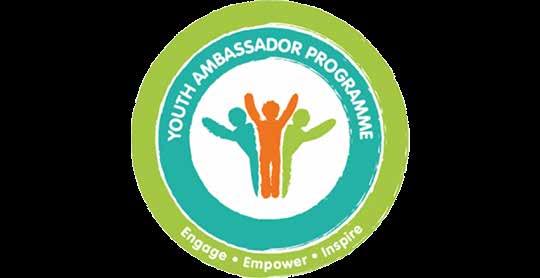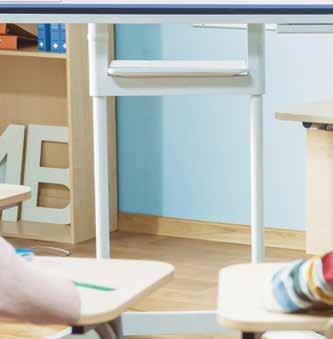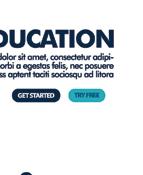






HWRK educational mag azine the online magazine for teachers SEPTEMBER 2022 / ISSUE 22 / FREE HWRKMAGAZINE.CO.UK WRITTEN BY TEACHERS FOR TEACHERS ALSO INSIDE What Does TRAUMA-INFORMED TEACHING Mean? STUDYING ERRORS - USING SHOW CALL IN THE CLASSROOM TEACHING AND RETRIEVAL OF NEW VOCABULARY TAKING LEADERSHIP TO THE NEXT LEVEL SEX EDUCATION IN CATHOLIC PRIMARY SCHOOLS LEVERAGING TEACHER TAPP FOR STAFF VOICE
We work tirelessly to change the lives of those affected by bullying and we know we make a difference. We see it in the way young people engage in our projects, how we empower them to Make a Difference and how they develop confidence and learn new skills.


By developing a positive ethos across a whole school/organisation community, we can create an environment that meets the emotional, academic and social needs of pupils and staff. Creating an anti-bullying and respectful ethos is a powerful way to Inspire Change.
Our Youth Ambassadors are a dynamic team of young volunteers working together to help deal with the issue of bullying. They are committed and dedicated and all have a passion to Make A Difference in their local commu nities. The programme is open all year round and you can join wherever you live and whatever your background and interests are.

CONTRIBUTORS
Christian Mba
@IAmMisterMba
Christian Mba is an Associate Assistant Principal at a secondary school in Northamptonshire. He is also the host of The En Pointe Podcast (@enpointepod).

Tracey Leese
@MrsqueenLeese
Tracey Leese is an Assistant Headteacher at St Thomas More Catholic Academy in Longton, co-author of Teach Like a Queen and a passionate advocate for women in leadership.


Katrina Quick
@katrinaisquick
Katrina has a degree in Journalism and a Masters in Creative Writing. She is a qualified English teacher, and prior to her career change worked predominantly within education after graduating from her PGCE in 2021.



Rachel Arthur
@MsArthurCompSci
Rachel is Head of Computing at Teach First. She is responsible for writing the Teacher Training Programme for all the computing trainees. Prior to working at Teach First, Rachel was an Assistant headteacher and also has gained industry experience working in Cyber security for PwC. Rachel is passionate about diversifying the computing curriculum.
Sarah Johnson
@PhoenixEdSarah
Sarah Johnson is the author of the book ‘Behaving Together: A teacher’s guide to nurturing behaviour’. She is a teacher and Senior Leader who has worked in a range of settings including both primary and secondary, psychiatric in-patient services, pupil referral units, hospitals, and specialist resource provisions for children with speech, communication and language needs.
Samuel Crome
@mr_crome
Sam is a Deputy Headteacher at a secondary school in Surrey, and an accredited executive and leadership coach. He researches high-performing, thriving teams, and writes blog posts about teamwork and how to apply key lessons to school teams. His blog, Pocket Wisdom, also records insights from a range of books, from Education, to Leadership, to Psychology.
Darren Leslie @dnleslie
Darren is a PT Teaching & Learning in Scotland. He is also the host of Becoming Educated, a podcast that aims to discover the secrets to great teaching.
Kelly Coleman
@kellycoleman23
Kelly is an English Teacher at an International School and previously 17 years teaching in the UK as Head of Department, Assistant Principal and Lead Practitioner as well as a GCSE Examiner.


Steffie Sadiq
Steffie Sadiq is a Year 6 teacher and History & Geography Middle Leader in a South-East London primary school with a love for creativity and learning.
Adam Boxer
@adamboxer1
Adam is Head of Science at a North London Academy and he blogs at achemicalorthodoxy.wordpress.com. He is a co-founder of Carousel Learning, a holistic online quizzing platform aimed at improving student retention in all school subjects.




Henry Sauntson
@HenrySauntson
Henry Sauntson is a Senior Leader and SCITT Director, based in Peterborough. His enthusiasm and interest lies primarily with teacher education and development, especially in the early career stageshe believes in the two ‘eff’ words of efficiency and effectiveness as hallmarks of teacher practice. Henry has contributed material to a number of journals and spoken at a range of events that celebrate the use of evidence in education; we need to be informed, not led.
Nikki McGee
@RE_McGee
Nikki McGee is the trust lead for RE at Inspiration Trust. As well as teaching three days a week and leading a SCITT programme, she is a curriculum writer and leads RE CPD for teachers at all key stages. In addition she is a member of the NATRE executive and often works with other schools and trusts to improve their RE offer.
hwrkMAG A zine.co.uk // M ee T T he T e AM @hwrk_magazine04 // hwrk MAGA zine // S e PT e MB er 2022
WRITTEN BY TEACHERS FOR TEACHERS
TIME FOR CHANGE?
It’s not often that so much change happens at once. A new monarch. A new prime minister. A new education secretary (again). Change is unnerving sometimes. It forces us out of our comfort zones and jolts us into thinking di erently. We might even act on it.
But what can we make of so much change in one go? The cognitive overload caused by the past month’s news cycle has started to dissipate and I’m left with just a few thoughts on what matters right now.
1. Leave nobody behind
The late Queen Elizabeth II once remarked “No age group has a monopoly of wisdom, and indeed I think the young can sometimes be wiser than us. But the older I get, the more conscious I become of the di culties young people have to face as they learn to live in the modern world”.
Keeping this thought at the forefront of our minds as we navigate what looks to be a tricky few months should serve us all well. It would also be a fitting legacy to the only Queen we have known in our lifetime.
School budgets are getting tighter. So are our own and perhaps even more so are those of the families we serve in our schools. We need to be ever-mindful of the ways in
which we can adapt our schools, to ensure that nobody in our communities goes without or is left behind.
2. Iterate, don’t innovate



In times of great change, we can be prone to going full-throttle into “doing things di erently”. Often, we don’t need to. We just need to refine them. Change for the sake of change, in case it works, is not sustainable and leads to burnout. Focus on what you do already and just make it that little bit better, piece by piece. Stability and steady progress is the name of the long game.
3. People, not policies
Of course policies and procedures are necessary - helpful even. But they aren’t an end in themselves. It’s the other “P”, people, that matters. Focusing on the needs of the people in our schools, students and sta alike, is how we will journey through these turbulent times successfully together.
Time for change? Possibly. But take your time, for a change.
Andy McHugh Editor | HWRK Magazine

EDITORIAL:
SEPTEMBER 2022 // HWRK MAGAZINE // 05HWRKMAGAZINE.CO.UK

WHAT IS “DEAD TIME” AND HOW DO WE CUT IT?





 By Adam Boxer
By Adam Boxer

According to the Cambridge Dictionary, dead time refers to “time when there is little or no activity.” Adam Boxer imagines within an educational context, that would translate to “time when there is little or no activity that would improve student outcomes.” This is what he proposes we do about it…







FEATURE
HWRKMAGAZINE.CO.UK SEPTEMBER 2022// HWRK MAGAZINE // 07
In a recent Telegraph article, headteacher Gareth Stevens argued that it was imperative to reduce “dead-time” in teachers’ timetables. To clarify his meaning, he referenced:
“…scheduling fewer internal meetings and centralising professional development online (thereby reducing duplication and travel between sites)”



Though I absolutely stand shoulder to shoulder with Stevens in trying to make teachers’ lives easier and their working hours more e cient, I’m not sure how scheduling fewer meetings would decrease dead time, unless those meetings were not contributing to student outcomes in the first place. Travelling to a di erent site makes a bit more sense, but is fairly niche and probably doesn’t apply to a great many teachers and leaders.
In general, teachers are worked o their feet, busily shuttling from one activity to the next; be it preparing resources, marking, data entry, parental conversations, duties and meetings – not to mention the actual teaching. Anything we can do to reduce that burden without negatively impacting student outcomes is a good thing so it is worth applying Stevens’ introduction of dead time in a more realistic way.
Dead time in meetings
“Reducing the number of meetings” is also a bit of a blunt instrument. You might have ten agenda items to get through over the course of five meetings, so reducing the number of meetings just means you will increase the length of the meetings, rush agenda items, skip agenda items or end up re-instituting the previous number of meetings.

Despite this, there are ways that meetings can be improved to limit the dead time within them.
For example, all too often, you might have seven colleagues at a meeting, and an agenda item that only relates to five of them. You therefore have two otherwisebusy teachers experiencing dead time. To remedy this, have a hard rule that you don’t discuss things in meetings unless they apply to everyone there. You can arrange your agenda so that these “exclusive” items happen at the end so you can invite the “excluded” colleagues to leave without missing any subsequent items.
Other meeting dead times include waiting for colleagues to arrive. If someone is late for a meeting, then having everyone else
wait for them is unfair. Instead, start the meeting on time, and then afterwards have a conversation with the late-comer and explain that you can’t hold everybody up for them and they need to arrive on time. If it happens again, graduate to a Conversation, followed by escalation to a Strong Conversation if there is re-o ence.



Another potential dead time to consider in meetings relates to “banter.” Having a joke in meetings and a bit of levity can be good for team spirit and morale, but you will definitely have colleagues that don’t enjoy it at the best of times, and at the worst of times are wondering why they are spending time listening to jokes rather than getting on with their work or going home to see their family.
Dead time reading emails
Most schools have an email problem. A full treatment of this is beyond the scope of any one article, but one obvious issue sticks out: reading an email only to find it doesn’t apply to you. You receive an email about 25 students who are missing Thursday afternoon because they are on a trip. The email has lots of detail about when they will be leaving lessons and where to send them and what they are doing and why and which students

@hwrk_magazine08 // HWRK MAGAZINE // SEPTEMBER 2022
haven’t been invited and how wonderful it is for their personal development and how neatly it fits in with the Gatsby benchmarks or whatever (sounds like someone has an NPQ project…). You scroll down all of this just to find that you don’t teach any of the students on the list. You have just experienced dead time, as there’s no way that time you’ve invested in reading the email will improve your students’ outcomes.





It gets worse. You probably received that email three weeks before the day of the trip. Then, on the Thursday morning, you get the email again with a reminder that lots of students will be out of school this afternoon. Having no recollection of reading this email three weeks ago or whether your students were involved, you check it again and find that… you’ve just been hit with dead time round two.
Teachers and leaders need to foster a more sensible email culture, where one cardinal rule should be: never send an email to someone who doesn’t need to read it. This includes all sta emails, emails sent to groups of teachers, or emails with reminders sent to people who have already done the task. For example, if you asked five teachers, two weeks ago, for an SEND Annual Report form on a particular student, don’t just press “reply all” and
send out a “polite reminder” on deadline day. If I sent it back to you two weeks ago, I now need to go hunting through my sent items to check again (because why would I remember?). Instead, never send an email to someone who doesn’t need to read it and check whether each recipient needs to receive a reminder.
Dead tech time

Wastefulness relating to bad technology can also fit into the dead time bracket, though solutions might be less obvious. At a school I used to work at, it took around four minutes to log on to a computer every morning. That might not sound like a lot, but by the time you’ve multiplied that time by every member of sta , often more than one login per day, and 190 school days, you’re up to quite a large quantity of time.
In a similar vein, I’ll send some work o to the photocopier and walk the 45 seconds to the closest copier, only to find there is a large queue. I then walk another 50 seconds to get to another copier, to find that it has no paper. I must now walk to the reprographics room to get paper, and by the time I am back someone has already filled it up with paper from another source and is printing 32 booklets. That’s a lot of dead time.



Solutions to technical issues like these aren’t straightforward because they are heavily context dependent – each school has its own long-term digital strategy that suits its needs, sta ng and available resources. But feedback loops here are crucial: when I’ve been on my morning tour of the school in search of a photocopier, do I just chalk it up as “one of those things” or do I raise it through the appropriate channel as something that happens regularly, slows me down and increases my dead time? Do leaders consider this as just as important as “sexier” workload-reducing initiatives like cutting back on marking or data entry?
I think this leads on to a unifying conclusion, that spans all forms of workplace ine ciencies – not just dead time. We need to consider our working time as precious. We need to note that every second we spend should be aimed squarely at the target of “improving student outcomes.” And if it’s precious, we shouldn’t waste it, and we should fight for it when we feel it is being squandered.

HWRKMAGAZINE.CO.UK SEPTEMBER 2022 // HWRK MAGAZINE // 09 FEATURE
“We need to consider our working time as precious… And if it’s precious, we shouldn’t waste it, and we should fight for it when we feel it is being squandered.”
develop

Novel
cycle
By Christian Mba
can

@hwrk_magazine10 // HWRK MAGAZINE // SEPTEMBER 2022 There is much work to do around recruitment, retention and workload, to
the long-term attractiveness of the teaching profession. Christian Mba explains why our pursuit of high-effort teachers
lead to a vicious
of burnout.
A
WAy To Address TeAcher reTeNTioN
Unprecedented. It’s almost as if this word didn’t exist before March 2020. It did (possibly in a glass case with a sign that read ‘for use in the event the UK comes second in Eurovision and/or in the event of a global pandemic). There were so many unprecedented events that it almost became cliché to say an event was unprecedented. Post-covid (if I can say that) who could have anticipated the impact it would have on every aspect of our lives, particularly our concept of work?
Cue The Great Resignation. The term refers to the higher-than-usual number of employees voluntarily leaving their jobs since late 2020 and early 2021. But in teaching, we know that this phenomenon has been taking place quietly for over a decade now. I always feel a sense of sadness when I see a blog post or tweet by another teacher leaving the profession. There are many reasons why teachers leave the profession. Some are personal and specific to the individual; many are to do with macro issues within the wider education system in the UK.
There is much work to do around recruitment, retention, and workload to develop the long-term attractiveness of the teaching profession. The issues with the education system are well-rehearsed and not the focus of this piece. While we must keep a clear view on the future, there is a risk we may miss what is happening in the present. In my opinion, there are several schools engaged in what I call The Boxer Paradox.
What do I mean by this? Well, it’s an idea based on Boxer from Orwell’s Animal Farm. First published in 1945, Animal Farm is a satirical allegory that tells the story of a group of farm animals who rebel against their human farmer, in the hope of creating an equal society. Aside from Orwell’s political commentary, he introduces several memorable characters, with Boxer being my personal favourite.
Boxer was the admiration of everybody… always at the spot where the work was hardest…His answer
to every problem, every setback, was
‘I will work harder!’ - which he had adopted as his personal motto. But everyone worked according to his capacity. (Orwell, 1945:17)
Everybody has encountered a Boxer; a highly motivated individual who seems to flourish in the face of challenges. Orwell describes Boxer as being able to do the work of three horses, making him an invaluable asset to Animal Farm. It seems that his motivation was predicated on his belief that he possessed the potential to develop his abilities through the exertion of effort. Boxer exhibited the type of resilience and motivation that most, if not all organisations crave for in their employees, especially in teaching.
Consider how many teaching vacancy adverts seek to employ ‘an inspiring and enthusiastic teacher’ or ‘dynamic and inspirational teacher’ or ‘passionate and enthusiastic teacher’. Of course, these are the types of individuals we should seek, recruit and employ. This is the type of



HWRKMAGAZINE.CO.UK SEPTEMBER 2022 // HWRK MAGAZINE // 11 FEATURE
“once we have sourced these motivated individuals, what are we doing with them?”
teacher I have aimed to be throughout my career; these are the people I want teaching my children. More than ever the education system in England needs highly motivated teachers and school leaders, skilled professionals able to develop their capacity to prepare young people for an unknown and unpredictable future.
But my point is this: once we have sourced these motivated individuals, what are we doing with them? Like Boxer, these individuals work hard, they are resilient, they possess an internal locus of control, willing to work harder to overcome setbacks. And yet Boxer, the hardest working animal on the farm is sent to the ‘knackers’ having exhausted his ability to keep working hard: The Boxer Paradox. His unexpected and callous demise in the novella reveals that Boxer was only ever a commodity. He was used until he could serve no other purpose than to supply the ingredients for glue.
At the outset, I am sure nobody, least not Boxer, would have imagined that his story would have concluded in the way it did. It is here that I see parallels for schools in the UK. Schools are under pressure to secure the best outcomes for the young people we serve. This is not possible without a skilled and motivated workforce. We ‘do it for the kids’: it is the due north of our moral compasses. So, when faced with problems, challenges and setbacks that come with education, we simply roll our sleeves up and say ‘I will work harder’. Schools however, like Animal Farm, can quickly become ‘greedy organisations’ (Gronn, 2003 cited in Bottery, 2012:457).
Not intentionally, but faced with the bottom line, it is easy for schools to put blinkers on and gallop towards shifting metrics of success, leaving in its wake broken professionals and knackered careers. It should be a concern to us all that we are churning out teachers. It is almost as though the process goes: recruit, burnout, repeat. Bottery (2012:458) rightly contends that educational leaders and schools must reject attempts to ‘extract all available work, every last drop of effort, in order to rack up record results in a more efficient manner’. Within education, teacher motivation is a rich, natural resource which must be sustainably sourced, otherwise the overuse and depletion of this resource will lead to the decline in the quality of systems overall (Bottery, 2012).
However, this is not me railing against accountability. We should be held accountable for what we do in our work as educators. We know that we have a professional responsibility to our children and young people, their families, and the wider communities we serve. I am writing here about the professional responsibility we have towards each other, the other adults in the building. When a parent sends their child to our schools, there is an unspoken pact that we make that says: ‘Don’t worry. Your child is safe here. We will look after them.’ I believe the same should happen with colleagues when they respond to our adverts seeking motivated, inspiring and enthusiastic teachers. We should make the same pact: ‘Don’t worry. You will be safe here. We will look after you.’
It has been my distinct privilege to work with early career teachers, as well as experienced colleagues and to support them in their careers, to develop them as leaders and to watch them flourish in their next steps. It mirrors the work we do with our children and young people; our schools should be places where everybody grows, everybody learns, everybody has an opportunity to be the best version of themselves.
In the medical profession, doctors take an oath to ‘first, do no harm’ recognising the preciousness and value of life. The best school leaders I have worked with and observed have been guided by a similar set of principles, seeking to create school cultures that nurture and elicit teacher motivation in a balanced way.
I am thankful to work in a school where this is the case, where staff are looked after; their motivation sourced sustainably to ensure that both staff and students flourish. We cannot immediately solve the issues that exist within our wider educational ecosystem, but we can create individual school climates where teachers willingly offer up their discretionary effort because their work is appreciated and acknowledged; they are valued and nurtured; they are safe.
This will not solve the recruitment/ retention crisis overnight, but it would go some way to ameliorate the levels of teacher attrition we are currently seeing. Many schools across the country have already crafted cultures that make them great places to learn, work and grow. Imagine if that was the case in every school – that really would be unprecedented.
“When a parent sends their child to our schools, there is an unspoken pact that we make that says: ‘Don’t worry. Your child is safe here. We will look after them.’ I believe the same should happen with colleagues”

@hwrk_magazine12 // HWRK MAGAZINE // SEPTEMBER 2022


LEVERAGING TEACHER TAPP FOR STAFF VOICE



 By Samuel Crome
By Samuel Crome
FEATURE
How do you create a school culture of genuine listening? Samuel Crome has been using Teacher Tapp at his school to inform decision-making and to encourage reflection on those decisions. Here’s how it went…
HWRKMAGAZINE.CO.UK SEPTEMBER 2022// HWRK MAGAZINE // 15
“how do we seek feedback in a way that is conducive to people being honest, focused, and so that we can address their ideas?”
At the height of the pandemic, school leaders were having to make daily decisions about how to best keep their communities safe. Often, there was little in the way of firm direction from the Department for Education; every choice had pros and cons, and every stakeholder had a different view. Some felt that the measures schools were taking were too extreme, while others felt they did not go far enough to protect students and staff from COVID-19.
This period, while chaotic and pressured, was a good chance for leaders to consult their staff about certain choices that lay ahead. How should we keep bubbles separate? Which method of lunch-time staggering do you think works best? How do you feel about meeting in person, even with social distancing?
There’s no doubt that the pandemic brought communities together. Nothing galvanises a group like a sense of shared struggle or a common aim. Put simply, we looked after each other, and tried to communicate as best we could.
The 2021-22 academic year brought new hope for a COVID-free era, but that didn’t quite work out. Schools still had to operate in a ‘business as usual’ fashion, with Ofsted inspections resuming and exams taking place regardless of the disruption caused to learning. For our school, the question was, how could we take the way we consulted with staff in a period of crisis, and begin to normalise a sense of feedback about other areas of school life?
Ultimately, our aim was, and still is, to improve staff wellbeing at our school, so that it is the best possible place to work, while creating a safe culture to feed back. We knew that coming out of COVID we’d need to review how we did just about everything. Workload. Policies. Behaviour. Community life. The calendar. So the next question was, how do we seek feedback in a way that is conducive to people being honest, focused, and so that we can address their ideas?
To begin with, we launched a standalone staff wellbeing survey. We used validated, benchmarked questions from WhatWorksWellbeing, on Microsoft Forms. It was quite a large survey, covering general health and wellbeing, wellbeing at work, school leadership and management, workload, etc. The survey was sent out for staff to complete during an INSET day, so that they had dedicated time to do it.
After two years of asking mainly logistical questions about hand-sanitising and bubbles, this was a chance for staff to give us other feedback about their work. It was illuminating. They had a lot to say. Some of it positive, some of it constructively not so positive! We read through it carefully, felt glad that we outperformed other organisations in many of the benchmarked questions, and tried to spot trends and patterns.
The problem with a long survey that only occurs every year or six months, is that staff bring different ideas and feedback from across a wide time span. This means that the answers can lack focus or include

events that have since long passed. Having multiple sections means that staff can get survey fatigue, too, which can reduce the validity of the responses.
Luckily, I saw that Harry Fletcher-Wood (teacher, author, and now Teacher Tapper) was launching a Teacher Tapp pilot scheme for schools to run their own Teacher Tapp surveys, and we leapt at the chance to be involved.
The premise of these surveys is that school leaders can set them to occur once a fortnight, twice a half term, or once a half term. The process is simple: Teacher Tapp sends the school’s Survey Lead a link, they then set up a survey by choosing categories and questions, and the date range for the survey to be sent to school staff. One working day after the survey concludes, Harry sends the survey /data, crunched and displayed in a clean, easy to access manner.
Question categories cover a variety of school business, such as wellbeing, workload, marking, behaviour, CPD, and many more. Over the course of the pilot, the dashboard has improved, the question range has increased, and Harry’s communication has been unfalteringly frequent and positive.
We went for the fortnightly option, and started by explaining to staff what we hoped to achieve, and what we were asking of them – in essence, it was to fill out a 2-3 minute survey once a fortnight. After each set of results, we sent out a report with the feedback and discussed how we might take some of that feedback into consideration.
“forums, which are voluntary, allow staff to engage with topics in more detail, engage with other perspectives, and to contribute to a process that may involve the school changing”
@hwrk_magazine16 // HWRK MAGAZINE // SEPTEMBER 2022
In summary, we’ve discovered a variety of benefits from using Teacher Tapp in this regular manner:
• It keeps surveys specific and focused
• Little and often means staff have a regular voice – nothing is harboured over months


• Leaders don’t accrue too many bits of feedback at once, so it’s more possible to action changes based on staff survey results
• Survey results are benchmarked against schools like your own, giving a point of reference

• It’s easy to keep track of the different survey results

How we used the data and began to create a feedback culture
Firstly, it’s important to keep a summary of trends you are noticing in surveys. We created a table of survey data summaries, planned actions, and completed actions, to make sure that staff feedback was being acted upon. The data that you amass along the way is only valuable if you use it as a first step in understanding how people really feel. Sometimes a survey might prompt a follow up in a briefing or a separate survey. It’s vital that leaders interrogate trends further so that they can truly understand what’s behind a few clicks on the Teacher Tapp surveys.
So, surveys are only the first step. We set up staff forums that run once a half term which aim to focus on certain issues or trends that we’ve noticed in the surveys or through other feedback. Each forum has one focus, such as marking, communication, parents, and we run it in the format of a focus group, trying to be consistent with our questions and in the ways we give everyone in the group a chance to discuss and share. These forums, which are voluntary, allow staff to engage with topics in more detail, engage with other perspectives, and to contribute to a process that may involve the school changing the way things are done. Next year, we also plan to introduce a more holistic wellbeing group, which discusses the school’s overall provision regarding wellbeing, not just specific topics.
FEATURE
Over the course of the year, as we had more data coming in, and therefore more actions to be taken, we began to create a school workload and wellbeing charter. This allowed us to reflect upon what already made the school a great place to work at, as well as piecing together what we were doing to improve this provision. We see this charter as a live document – a commitment to what we have done and what we want to do, but not completed. Not ‘ticked off ’.
As I stated at the beginning of the article, our aim of the surveys and forums was twofold: to make the school a better place to work, and to improve the culture of open feedback, so that staff felt safe to evaluate and comment upon aspects of school life.
Developing and evaluating the role of surveys and staff feedback
The first year of this process was very much about normalising staff feedback and surveys. Teacher Tapp has been a brilliant tool to create concise, targeted surveys that are easy to access and provide excellent analysis from Harry and the team. Now we are looking to build on those in a couple of ways.
Firstly, we will slightly increase the length of the surveys so that we can create a little more depth when we ask for feedback; now that we are used to collecting data, this slight increase (i.e. going from 5 questions to 8-10) won’t lead to us drowning in feedback. But next, and excitingly, we are a Multi Academy Trust using the Teacher Tapp Mat-wide service. This means that not only will our survey results be benchmarked against schools like ours, but also alongside other schools in our MAT, which means we can create more cohesion between how the MAT works with our schools.
This article is an endorsement of creating a culture of psychological safety, where leaders ask for feedback and the knowledge and lived experiences of staff to help them improve school life. We believe that surveys, forums, and a creating a shared charter are good starting points for that sort of culture. Teacher Tapp is undoubtedly a brilliant tool to help you with that journey, and if you’d like, I’d be happy to talk further about how to get the most out of it.
HWRKMAGAZINE.CO.UK SEPTEMBER 2022 // HWRK MAGAZINE // 17
IncreasIng The UpTake Of gIrls In gcse cOmpUTIng
Are enough girls going into Computing? And if not, what can be done about it? Rachel Arthur explores this complex issue…
By Rachel Arthur
With Computer Science now becoming the fastest growing degree subject, with 24,900 people due to start courses in September – up seven percent on previous years you might expect to see similar growth in minority groups choosing to take the subject. This year fewer girls took a GCSE in Computing than boys, in fact, only 22% of the entrants in 2022 were female.
But despite fewer girls picking the subject, they did perform well with 40.6 percent of female entrants in England gaining a grade 7 or above, compared with 32.2 percent of male entrants. While this doesn’t give us the full picture of their performance and progress compared with other subjects it does show that the girls achieved strong grades in GCSE Computing.
So what is the problem?
The data are clear – diverse teams perform best in all industries, including in tech. However, the pipeline of female computer scientists is not meeting the demand for a more diverse workforce. In 2019, only 19% of jobs in tech were filled by women according to a report by Women in Technology. This is something that needs to change, and this change must start in schools.
So, why are so few girls choosing to take the GCSE and what can we as teachers do to help address the balance?
Practical tips for increasing uptake:

1. Make it relevant.
Computer Science can be seen as a very abstract concept – especially when teaching programming. The amount that pupils need to learn about the concepts of programming in order to write code can make it feel so far removed from the application.
Four principles were proposed by Guzdial and Tew (2006) to help pupils contextualise their learning:
• Learning activities were aligned with real-world scenarios
• Topics were aligned with students’ interests
• Assessments were aligned with the material which had been taught
This can be brought into your classroom by aligning your curriculum to projects that would be used in industry. Take
your HTML scheme of work and turn it into a course in becoming a web designer with client briefs and projects from local businesses. These small tweaks make your curriculum more relevant.

2. Create a sense of belonging
Research suggests that the most important factor for girls taking GCSE Computing is the feeling of being related to others and that a sense of belonging was a significant predictor of their motivation.
This need for a sense of belonging is a vicious cycle as if girls do not see themselves represented then they are often not motivated to study the subject. This then means there are no role models for the next cohort.
To break this cycle, you can bring more female role models into the classroom from industry or previous cohorts to increase that sense of belonging.
There is a lot of research into the type of role model we should use in the classroom which is discussed in the Factors that impact gender balance in computing report by the Raspberry Pi foundation.
@hwrk_magazine18 // HWRK MAGAZINE // SEPTEMBER 2022
“Often a barrier for pupils picking Computing is their parents’/carers opinion on the subject, so why not pick up the phone and have a chat about the benefits of their child doing Computing?”



HWRKMAGAZINE.CO.UK SEPTEMBER 2022 // HWRK MAGAZINE // 19 FEATURE
3. Clubs and activities
A great way to create a sense of belonging in your classroom is by running clubs and activities. Simply having a chat with the girls in your lessons, telling them that you’d love to see them at the after-school club, and making it clear it is for them and that they are welcome can have a huge impact on attendance.
Some suggestions of great clubs and activities to look at:
•
There
a fuller list of general
4. Parental engagement
Many studies have identified gender differences between learners in their attitudes towards Computing. When I was in the classroom, I heard pupils say “girls don’t do computing”. But where do these attitudes come from?
Expectancy-value theory (Eccles et al., 1998) suggests that subject choice and career goals are affected by pupils’ expectations of what their parents and society think. There is also research to suggest that pupils are more likely to choose Computing if they feel supported and think they have a chance to succeed academically (Lent et al. 2008).
Targeting girls with positive phone calls home, especially in the run-up to options deadlines can have an impact on parents/ carers as well as on pupils. Often a barrier for pupils picking Computing is their parents’/carers opinion on the subject, so why not pick up the phone and have a chat about the benefits of their child doing Computing?
When I was teaching this was my favourite way to end the week and remain focused on the positive things my pupils had done!
5. Careers
There can be a misconception that careers in Computing involve sitting in a dark room programming and this can be (understandably) off-putting. Combat this misconception by sharing how your lesson links to lesser-known computing-related careers that may spark the interest of your pupils.
The national careers service has a long list of careers that might be a good place to start!

6. Cross-curricular links
To help demonstrate the breadth and reach of computing it can be a nice idea to establish some cross-curricular links. There was a lot of love for the links with music through Sam Aaron’s Sonic Pi as a simple and effective way to do this.
The Raspberry Pi foundation has also held a series of education research seminars on this topic – so they are always worth catching up on.
7. Classroom environment
Changing the appearance and layout of their classroom can have an impact on girls’ attraction to the subject according to a recent report from the US, Stereotypes Undermine Girls’ Interest and Sense of Belonging in Computer Science. The research looked at 270 classrooms across the US and asked girls if they felt like they belonged in the subject. The pupils were shown two different computer science classrooms.
The first classroom was decorated with stereotypically geeky features such as science fiction books and posters, whilst the other was filled with art and nature posters, general-interest magazines, and plants. While the male students were indifferent to the two classrooms, 68% of female students chose the second classroom, revealing they were three times more likely to sign up for a Computer Science class if taught in such an environment.
So, why not swap out some of your displays for images of nature and plants to see if it makes your classroom feel more inclusive to girls?
With the world becoming more digital every day it is so important we equip all our pupils with the skills they need to access the technology careers of the future, so why not try some of these tips and see if it impacts on the participation of girls in GCSE Computing at your school too?

@hwrk_magazine20 // HWRK MAGAZINE // SEPTEMBER 2022
Cyberfirst • dressCode • Sonic Pi
is
competitions on the CAS website too.
PEDAGOGY



























HWRKMAGAZINE.CO.UK SEPTEMBER 2022 // HWRK MAGAZINE // 23
24. What Does Trauma-Informed Teaching Mean? Approaches to trauma-informed teaching and how they improve our teaching 26. Studying Errors - Using Show Call In The Classroom A practical guide to using the TLAC strategy: Show Call
PEDAGOGY








WHAT DOES ‘TRAUMA INFORMED’ TEACHING MEAN?








Being trauma informed is central for e ective discussion on how we can promote a school culture which supports all children to learn and develop. Sarah Johnson explains…


 By Sarah Johnson
By Sarah Johnson
Behaviour is complex. Teachers consider a wide range of children’s needs and juggle competing demands. The skillset required to be a teacher is enormous; from knowing the curriculum, e ective pedagogy, making sure children remember what they have learned to then being able to deal with the myriad of ways that children may behave.
In more recent years, the topic of being “trauma informed” has entered into teaching discourse. I don’t remember it being there when I started teaching in a psychiatric unit twenty years ago but now, often liaising with mainstream schools and Pupil Referral Units, terms such as “adverse childhood experiences” and “trauma informed” are common parlance, just as much as “behavioural policies”, “warmstrict” and “zero tolerance”.
Being trauma informed is not the panacea that o ers perfect behaviour in every class and every school. However, it has never promised to be and nor should it be. Nor is trauma informed about the allowance of children to do as they please without consequence or sanction. Being
trauma informed is another part of our e ective toolkit to support children’s emotional well-being, help them understand their emotions and to look at our own responses to further support a child in a period of distress.
The term ‘trauma informed’ is often used to denote an approach which hopes to delve deeper into why children may behave in certain ways. Why they may shout, cry, throw things, or otherwise demonstrate that they’re upset. It might also serve to remind us why some children might not talk in front of their peers, may struggle to finish tasks, or find it di cult to come to school on time.
The role of trauma informed practice is to raise awareness amongst all sta within the school or wider organisation about the e ects of trauma and how we ensure that our approach, environment, and interactions do not serve to traumatise or re-traumatise children that may have experienced adversity. Being trauma informed is not just about being informed about trauma but is also about being curious about what may be driving behaviour or whether there are underlying issues.
I have heard the term ‘trauma informed’ practice being talked about as if it is antagonistic to robust school behavioural policies, rules and subsequent consequences. However, the aims of both systems can go hand-inhand and have the same aims; an environment where all children can learn and be safe.

For me the core of some of the dichotomous conversation is to find some common ground, which there are many. Firstly, in building a culture around behaviour, it is important that the rules make sense. Children that have had chaotic experiences in the past benefit from understanding what the rules are, how they are applied and if there are exceptions why these exceptions are being applied. In fact, children without chaotic experiences in the past are likely to enjoy the same benefits.
Furthermore, it is important that we anticipate issues and address them if they are arise with open dialogue about what the challenges might be. For example, as we return to school, we are probably fairly used to seeing local newspaper headlines decrying uniform rules.







@hwrk_magazine24 // HWRK MAGAZINE // SEPTEMBER 2022
PEDAGOGY














However, there are myriad reasons why a child may not bring in their PE kit; from poor organisational skills, being embarrassed about not having the right equipment to being too worried about changing in front of others. Simply, following a pre-determined consequences of perhaps a detention does little to change the underlying issue.

















Instead, as part of our toolkit we should find out what the di culty is in abiding by this rule and then look at strategies. For example, how we can support a child’s organisation so that they are able to remember what is needed and on what day. We can talk both to parents and their child about where they can source the correct PE equipment without the financial burden.
We are in a position in which we can provide support or alternatives for children that may feel physically






exposed in a changing room or overwhelmed by the noise. In looking deeper, beyond what is being presented, we can address the behaviour that we actually want to change.





In some of the work that I do I talk about the need for curiosity to understand how a child might be presenting within the classroom and within the wider school community. The first step is noticing – what are we really seeing when a child does something and how can we then start to build a bigger picture in identifying the reason for that behaviour and therefore our understanding before we respond? This is to see behaviour within the wider context. Humans interact in lots of di erent ways depending on their own experiences, what reaction they received in the past or simply because behaving in that way is fun or asserting their own
independence and autonomy.
Is a child humming because it is fun to avoid work, or perhaps because they can’t do the work, it helps them concentrate, or maybe it is because it is a part of a wider neurological di culty such as Tourette’s syndrome? If we just jumped to the response and reaction aspect then the behaviour will change, and in some instances, it may not even be appropriate to try and change it.
Being trauma informed is a vital component in working with other people, it recognises the huge diversity of child and adult experiences. It reminds us that we need to be mindful of the environment that we create within a school community and that we aim to support access to learning in a way that not only feels safe but is safe for all those that enter the school space.
SEPTEMBER 2022 // HWRK MAGAZINE // 25HWRKMAGAZINE.CO.UK
“Being trauma informed is not just about being informed about trauma but is also about being curious about what may be driving behaviour or whether there are underlying issues.”
PEDAGOGY
STUDYING ERRORS - USING SHOW CALL IN THE CLASSROOM





Done well, “Show Call” is a powerful tool for supercharging your students work. Not only does it keep them on their toes because it could be their work that is shown, but it can also create a culture where all students are keen to help one another improve. In this piece, Darren Leslie explores how he uses Show Call in his lessons.
 By Darren Leslie
By Darren Leslie
One of my favourite techniques from Teach Like a Champion 3.0 is Show Call. Show Call is where you visually share a students work with the class using a visualiser or another tool that can project an image. Show Call a ords us several opportunities in our teaching, we could live mark a piece of work, we could praise a student by sharing their best work and we could display work that is incomplete and study it with the class with the aim of improving the work. Over time I have come to prefer the latter. Taking a student’s incomplete work and helping them to make improvements using their classmates’ ideas is becoming a key feature of my classroom.
Lemov asks “what’s the quickest and most productive way to respond to an error in the midst of teaching, in other words? Often, it’s to study the error itself”. And it is this his idea
that forms the basis of how I use Show Call in my classroom. I use it to respond to student errors and instead of o ering the student feedback in the moment I take their work, project it onto the board, and then proceed to ask their classmates for their ideas of how to improve the work, where they might have gone wrong and to check that we can all identify errors in one another’s work.
Building a classroom culture where this is part of the day-to-day workings of the room takes time and in the early days of teaching a class, I will project complete work that is correct and use it as an opportunity to live mark and provide praise for the student whose work is being projected. This helps to normalise the technique and build awareness that at any moment I may take your work and share it with the class. Getting this right is vital if we are to progress to using Show Call to its full potential.
Over time I will begin to take student work that is incomplete, missing a key step or with a few common errors so that we can study the error together, as a class. There are some key ingredients to getting this right and that begins with what Lemov calls ‘the take’.

THE TAKE

The goal is to make the take feel familiar to the student, like an everyday occurrence that is safe, and that nothing bad will happen.
The first few times I project a students work I will o er a quiet explanation: “your work is great. I would love to share it with the class” or “this is brilliant. I’d love to share it”.
As it becomes routine, I transition to taking their work with them knowing it will be shared. First by letting them know, “this is great. I can’t wait to share it” and slowly moving onto to seamlessly taking their work with a nod of thanks
@hwrk_magazine24 // HWRK MAGAZINE // SEPTEMBER 2022
PEDAGOGY







SEPTEMBER 2022 // HWRK MAGAZINE // 25HWRKMAGAZINE.CO.UK
“what’s the quickest and most productive way to respond to an error in the midst of teaching, in other words? Often, it’s to study the error itself” (Lemov)
PEDAGOGY
and appreciation helping to communicate the normalcy of this in the classroom. Throughout, a smile and a thank you go a long way in helping to build a culture where the students are comfortable with sharing their work and the practice of studying errors.
After the students recognise that sharing their work is part and parcel of the classroom, I can then begin my circulation by declaring, “I am coming round to look for great work to Show Call”, making it something for the students to strive for in the classroom.
Getting this part right is arguably the most important aspect of a Show Call. We would never want to humiliate a student or make them feel targeted so being super selective on whose work you Show Call, especially at the beginning will help to generate a culture where students work is studied deeply.
THE REVEAL
The way that we ‘reveal’ work will shape how students interpret it and sets the tone for the work that lies ahead. Initially, I won’t name the student whose work is being beamed onto the projector. I will state that “we are going to look at someone’s work and talk about it for a little bit” setting the scene for the discussion to follow. It’s important to note that the tone that you use needs to be as casual as possible, like this is the most normal thing in the world to happen.
As we begin to study errors more deeply naming the author of the work can come into play but often maintaining anonymity can be super powerful. We could move onto saying “let’s check someone’s work to see if they remembered
to simplify their fraction” and if we wanted to use names we could say “Here’s how Daisy solved this problem. What do you think?” or “Martin has made a simple common error. Take a minute to look at his work silently to see if you can spot it”.
Now that the work has been displayed and the students are giving it their full attention what happens next should always focus on getting better and helping the students get better at the task in hand.
THE COGNITIVE WORK








As the work is being beamed onto the projector from under the visualiser an important part is considering how you want the students to interact with it. Perhaps they could read it silently for a minute and compare it with their own work or maybe they could discuss it with a shoulder partner. Whatever path you choose making sure that it is the students that are doing most of the cognitive work is key. You could say “take a minute to silently read Jamie’s work” followed by “take thirty seconds to share with your partner how you would solve this problem”.
With either option I would then cold call a student to have them share their thoughts “Gabriel, what do you think?” or “Keira,
what should Jamie do to fix his error”. As the students are o ering their thoughts and building on one another’s ideas I will chart the conversation on the board over the top of the image being projected, helping everyone to keep on track. By now the students will have concluded and it is time to wrap up the conversation.
Sometimes, I will provide a review to make sure everyone knows how to fix the error we have just studied and other times I will say “as Keira mentioned Jamie needed to do this, so take a minute now to tidy up your work”. It is important that time is given for students to tidy their work and make any necessary changes before moving on.
Show Call is a regular feature in my classroom and with time it becomes a rigorous process for studying errors and what makes it powerful is that through questioning and probing it is the students themselves that improve the work of their peers. This builds a scholarly culture to the classroom that keeps the cognitive workout firmly on the side of the students.
@hwrk_magazine26 // HWRK MAGAZINE // SEPTEMBER 2022
EXPAND YOUR MIND ONE SUBJECT AT A TIME
32. Training Teachers: Exploring the ITE Curriculum

When
39. Teaching And Retrieval Of New Vocabulary
Tips
47. Sex Education In Catholic Primary Schools
Approaches
50. How I Would Teach... Plato’s Allegory Of The Cave
A
SEPTEMBER 2022 // HWRK MAGAZINE // 31@hwrk_magazine
it comes to ITE, it’s often not what you learn, but how you apply it that matters
for all subject areas on how to teach new vocabulary
to teaching the sensitive topic of sex education in Catholic primary schools
practical guide to teaching one of philosophy’s greatest stories, to Year 7
TRAINING TEACHERS: EXPLORING THE ITE CURRICULUM

Initial Teacher Education (ITE) is complex. In this piece, Henry Sauntson focuses our attention on what matters: not the curriculum itself, but how it is applied by today’s trainee teachers.
By Henry Sauntson
[On Teacher Educators] ‘our calling after all, is to shepherd and enable the callings of others’ (Ayers 2001).
The introduction of your friend and mine, the Early Career Framework (ECF) and it’s reverse-engineered progeny the ITT Core Content Framework (CCF) - is perhaps the biggest standardisation of Initial Teacher Education in a generation. A form of National Curriculum for teacher development, using an evidence-based approach and a series of Learn That and Learn How To statements that endeavour to bridge the gap between theory and practice.
We can perhaps see the CCF as a specification and the Teacher Standards as the mark scheme. From September 2024 it will be the duty of every ITT provider (many already do) to have ‘have a fully developed, evidence-based curriculum which explicitly delivers all aspects of the ITT Core Content Framework (CCF) and ensures that trainees are prepared for the next stage in their professional development as teachers, the Early Career Framework (ECF) induction’ (ITT Draft Criteria 24/25).
They must also consider the following:
• The curriculum must be designed in the light of the best evidence for effective teacher training and development
• Programmes must be designed to reflect how children learn most effectively and, wherever appropriate, reflect cognitive architecture in curriculum design
Furthermore, they should ‘integrate well-evidenced content into their ITT curricula, including relevant subject-specific content and critique of theory, research (including, where appropriate, their own) and expert practice’ and weave this into a ‘sequenced and coherent curriculum which supports trainees to develop their classroom practice.’
Back in 2000, Hillary Burgess looked to the future of teacher training, quite presciently: ‘It is important to note that with the introduction of the National Curriculum for ITT a new language has also emerged. Teacher education is now teacher training; students are trainees; the curriculum is expressed as a set of standards for
qualified teacher status (QTS) and subject knowledge is content; the expansion of school-based routes and employment schemes means that training institutions are often referred to as providers. All these terms hold implications for the way student teachers and student educators are perceived’ (Burgess, 2000, p406).
One of the biggest challenges providers face is not the design of the curriculum but ensuring that it is understood by all engaged in its implementation. The provider can put the content on the ‘road map’, but it is the trainee and mentor that oversee its implementation in diverse classroom settings; this is not easy to monitor, manage or manipulate.
There are many layers, each filtering the content from the Core Curriculum and adding their own twist, their own opinion, their own experience. With so many layers comes the possibility of a game of pedagogical Chinese Whispers - lethal mutations derived from surface-level awareness of terminology or concepts but perhaps lacking the firm knowledge base.
The provider MUST ensure
CURRICULUM @hwrk_magazine32 // HWRK MAGAZINE // SEPTEMBER 2022
HWRKMAGAZINE.CO.UK SEPTEMBER 2022 // HWRK MAGAZINE // 33 Initial Teacher Training
Teacher
HWRKMAGAZINE.CO.UK SEPTEMBER 2022 // HWRK MAGAZINE // 35 Initial
Training
Above all we must be careful with our language; everyone needs to know what terms mean, where they are drawn from and what implications they carry: Back in 1982 Joyce & Shower stated that ‘the conditions of the classroom are different from training situations; one cannot simply walk from the training session into the classroom with the skill completely ready for use – it has to be changed to fit classroom conditions’. An old reference, but a relevant concept – we have to build the language bridge that transverses the valley between theory and practice, paper and the classroom, the training room and the real-life manifestation.
As we move from the Core Content to the Hinterland we expand the frames of reference for our trainees; we give them the tools to be autonomous, to be individual. Robin Alexander stated that teachers should be able to give a ‘coherent justification for their practices, citing i) evidence, ii) pedagogical principle, and iii) educational aim rather than offering the unsafe defence of compliance – anything else is educationally unsound’.
By deepening understanding, mitigating lethal mutation through shallow implementation, providing training and a knowledge base that supports the use of language appropriately, we give purpose as opposed to ‘performance’; we believe in what we are saying in formative, professional dialogue –we aren’t just paying lip-service to terminology.
Language identifies individuals but also helps to build coherent
communities; trainees and mentors can still maintain their own identity and autonomy but operate within professional frameworks built on a core of shared understanding.
The evidence base on which the CCF - and therefore any accredited provider curriculum - is built has been contested, but it isn’t a closed book; there are opportunities to enrich, broaden and strengthen to suit context. A provider must, I feel, grasp the chance to personalise their curriculum beyond the CCF by embedding their own choices of evidence.
There’s still room to develop trainees as critical practitioners, capable of using educational research to inform their own developing practice - ‘subject-related educational research can play an important role in trainee teachers’ learning since it provides a disciplined perspective from which trainees can derive new ideas and understandings related to their own developing practice as well as a critical basis from which to formulate, examine and justify their views through reference to a wider, collective pool of experience’ (Counsell et al, 2000, p.467).
Whatever decisions a provider makes, they must believe in them; ‘standards, not standardisation’, as Shulman said - monitor, support, assure and, above all, contextualise.
Remember to make assessment the curriculum’s servant, not its master; communicate regularly to ensure efficient and effective practice, and respond to the needs of the individual trainee - one size fits very few.
The key to effective implementation across the various aforementioned settings is understanding; as recent work by Windsor et al indicates; ‘without understanding the different arrangements that both form and are formed by practices, professional development of teachers cannot be fully realised’ (Windsor et al, 2022, p.652).
It doesn’t matter how ‘knowledge rich’, ‘domain-specific’, ‘evidenceinformed’ or cognitively aware the ITE curriculum is on paper; it is how the trainee teacher manifests this into effective and efficient classroom practice that matters.
CURRICULUM @hwrk_magazine36 // HWRK MAGAZINE // SEPTEMBER 2022
References: • Ayers, W. (2001). To teach: The journey of a teacher (2nd ed.). New York, NY: Teachers College Press. • Hilary Burgess (2000) What future for initial teacher education? New curriculum and new directions, The Curriculum Journal, 11:3, 405-417 • ITT Accreditation Criteria - accessed via https://www.gov.uk/guidance/initial-teacher-training-itt-accreditation • Counsell, C., Evans, M., McIntyre, D., Raffan, J; (2000); The Usefullnes of Educational Research for Trainee Teachers’ Learning; Oxford Review of Education; 26:3; 467 - 482 • Joyce, Bruce R. and Beverly Showers. “The Coaching of Teaching.” Educational Leadership 40 (1982): 4. • Windsor, S., Kriewaldt, J., Nash, M., Lilja, A., Thornton; (2022); Developing teachers; adopting observation tools that suspend judgment to stimulate evidence-informed dialogue during the teaching practicum to enrich teacher professional development; Professional Development in Education; 48:4; 642 - 656
HOW CAN WE TEACH NEW VOCABULARY MORE EFFECTIVELY?
It’s no secret that students with better vocabularies are more likely to succeed in school. So how can we teach new vocabulary more e ectively, to help all students access education and to maximise their learning? Kelly Coleman explains…
By Kelly Coleman
In 1986, Gough and Tunmer presented a scientific theory called the Simple View of Reading. This theory looked at a student’s ability to understand written words depending on how well they decode them and understand their meaning. If they could comprehend these things, their reading comprehension would significantly improve.
Gradually, the teaching of vocabulary is coming to use

this theory to underpin the work that we do, notably, that word recognition and language comprehension work together and not in isolation. It is not just about teaching new vocabulary, it is about teaching it to a level of mastery that can be applied by students. ‘Mastery in early decoding leads to skilled reading. As readers become more proficient, they progress from sounding out each word to recognizing words instantly.’ (Parker, 2019)
Nowadays, vocabulary is at the forefront of our teaching, and it is not just down to English specialists to achieve this, but requires a whole-school approach. Despite GCSE exam papers being written for the expected reading levels of a 15 or 16 year old student, researchers have concluded that by Year 9, most students are reading at least 3 years below their chronological age (TES, 2018). This impacts all GCSE exams, regardless of the subject.
HWRKMAGAZINE.CO.UK SEPTEMBER 2022 // HWRK MAGAZINE // 39
Literacy
It is no wonder then that there has been such an array of pedagogical books by teaching professionals as to how we can reflect on how we embed the development of vocabulary in our long term curriculum, but also how we can teach it to our students so that they can retain this information. One well-known book has been Alex Quigley´s Closing the Vocabulary Gap (2018). In it, he has identified 7-steps to developing vocabulary:

One of the key strategies that Quigley emphasises is studying morphology – breaking down words by components and roots. It is not enough to read the words, students need to explore them and understand where they have derived from and how they can be used.
Since reading this book, I have experimented with various strategies for each step. Step 1 and Step 2 can work well alongside one another. Firstly, whole school CPD is often required to agree the main objectives and how each department can work smarter by identifying any overlaps and looking at consistent strategies than can be applied across the school so that students are exposed to the same patterns when exploring new vocabulary. This draws in to Step 2 in which departments can look at their learning journeys and long term plans, focussing on specific vocabulary that will be both essential knowledge, as well as achievable retrieval over time. For instance, rather than a knowledge organiser, I have been experimenting with vocabulary organisers for each unit in English. Students receive this at the start of the unit and every homework task is related to it, which is then tested every lesson through short tasks and questioning.
Rather than over-burdening students, the 5 upgraded key words have created a manageable task for students with words that can often be re-used in many different units (examiner tip: pick words with more technical spellings for students to learn and use in any writing task to help them achieve the higher levels at GCSE).
Currently, I work in an International School and a majority of my students have English as a second language. I trialled many of these strategies with my Year 8 class and was amazed that by our final unit of the year (Macbeth) they were able to accurately use, and apply, many of the key terms they had learnt in the first term of studying Gothic literature.
By this stage, we were building their analysis of this new vocabulary. Rather than simply understanding what it means and being able to use it, they were able to use the words for higher level questions such as “explaining the effect of the writer’s choices” –What does the word ominous mean? became How does Shakespeare present an ominous atmosphere? Here, it became possible for them to connect the words on our vocabulary organiser: Shakespeare presents an ominous atmosphere through Macbeth’s barbarous behaviour and grotesque vision of reality. Intentionally, he has given in to temptation and been manipulated by the supernatural creating a sense of foreboding for the deeply religious audience who would be fearful of the consequences.
CURRICULUM @hwrk_magazine40 // HWRK MAGAZINE // SEPTEMBER 2022
Literacy
Vocabulary Organiser


Example lesson task for new vocabulary.
Example homework task to investigate the word.

HWRKMAGAZINE.CO.UK SEPTEMBER 2022 // HWRK MAGAZINE // 41
Teach students tech-niques for learning the spellings. I play this game every lesson with one of the spellings and get students to create their own to test the class. Easy extension: what does it mean? Or write it in a sentence.


Get them using the words. Begin by giving them structures to help them explain these new words.
Model how to use the words to get them started. Many of my students have commented on how “posh” their work sounds!
I get them to highlight the words every time they use them accurately and reward them for doing so.

CURRICULUM @hwrk_magazine42 // HWRK MAGAZINE // SEPTEMBER 2022
Literacy
Test their knowledge of the words every lesson. What word starts with…? Can they match it to a synonym? Can they un-jumble it? Can they think of an antonym? Don’t let them forget the words!













HWRKMAGAZINE.CO.UK SEPTEMBER 2022 // HWRK MAGAZINE // 43
“It is not enough to read the words, students need to explore them and understand where they have derived from and how they can be used.”
Once Step 1 and 2 have been agreed, it is about looking at what strategies will work with your students.


In English, students have to deal with unseen extracts in which they will never know the meaning of all of the words in it. However, in exposing them to the skills of morphology and etymology, they can make a fairly accurate prediction as to what this new vocabulary could mean. Likewise, learning this more advanced vocabulary can develop their writing skills by challenging students to spell more complex




words, particularly if it is learnt over a period of time and used in every piece of writing that they complete in order to grow in both confidence and accuracy.
























Similarly, modelling these words in our spoken language, and being persistent when questioning students shows students that their vocabulary is transferable between each of the skills they need to succeed both at school, and once they leave school. I regularly, “pretend” I can’t remember a key word and the students I teach definitely enjoy knowing something more than me!
In the past, vocabulary development was taught through a glossary – copy new words and their definition in the back of your book – something students rarely looked at again, nor did it have any meaningful impact in understanding what the words mean or how they can be used. Now with the vast array of pedagogical readings, strategies and changes to exams, the development of vocabulary can be both exciting and challenging for our students and over time, and with a consistent whole-school / department approach, can have a positive impact on student progress.





CURRICULUM @hwrk_magazine44 // HWRK MAGAZINE // SEPTEMBER 2022
References: Gough, P.B. & Tunmer, W.E. (1986) Decoding, reading, and reading disability. Remedial and Special Education, 7, 6-10 Parker, S. (2019) Guest Post: The Simple View of Reading: Still Conclusive after 33 Years, The Snow Report, Pam Snow. http://pamelasnow. blogspot.com/2019/02/the-simple-view-of-reading-still.html Many GCSE pupils have reading level of a 13-year-old | Tes Magazine (2018)
“vocabulary is at the forefront of our teaching, and it is not just down to English specialists to achieve this, but requires a wholeschool approach”
TEACHING SEX EDUCATION IN CATHOLIC PRIMARY SCHOOLS

Sex education can be a tricky topic to teach and can be fraught with awkwardness, embarrassment and safeguarding implications. In this article, Ste e Sadiq explores how to approach sex education within the Catholic sector.

 By Steffie Sadiq
By Steffie Sadiq
Oh Year 6 - a year of SATs, production-preparation, residential visits and the all time favourite topic - sex education. Gone are the days where you could just stick a video on the tv and hope it explains everything for them!
With the rise of social media and accessibility to the latest technology, children are a lot more familiar with topics that would once have made us cringe - including sex.

With the world constantly changing, how we teach sex education is even more important now, if we are to aid our children’s development.
The DfE released a compulsory Relationships Education for primary schools (Relation-ships and Sexual Education for secondary) in 2020 which resulted in the release of a Catholic RSE, aimed predominately at teaching sexual education in accordance to the teaching of the




Although having a separate RSE policy ensures religious teachings are incorporated, it can be difficult to navigate teaching sexual education in a Catholic school, especially as children are aware of and inquisitive about the different types of relationships (i.e. same-sex relationships) while the majority of pupils rarely or no longer practise the faith.

HWRKMAGAZINE.CO.UK SEPTEMBER 2022 // HWRK MAGAZINE // 47
Catholic Church.
Relationships
and Sex Education
Before “the sex talk”…
Some procedures have proved useful in making sure all parties (children, parents and school) are comfortable and satisfied with sex education in a Catholic context.
As with any other subject, being clear on what should be taught and what the children should learn and remember is an important foundation. This means reading government policy as well as your school’s policy in deciding what to teach within your sex education lessons.
Once this is sorted, sending out a letter to the parents, which is recommended by the DfE, gives parents a very clear outline of the topics that would be covered, when they would be covered and provides them with an opportunity to ask questions and/or withdraw their child from the sessions should they choose to.
Surprisingly, I found that most parents actually wanted their children engaged in the les-sonsthey just didn’t want to be the ones to deliver it themselves! Once the go-ahead is given and parents are well-informed, it’s time to prepare for the trickiest audience yet - the children.
Though sex can be an awkward conversation to have, even among adults, it’s important that children are given the opportunity to ask real questions, in a safe space, without fear judgement or having their questions dismissed. As teachers, we have a duty to ensure we are preparing our children to grow into healthy teenagers who will make well-informed choices in their lives.
Below is some guidance that I find useful in preparing the children to have a mature, yet age-appropriate, conversation about sex (this is even before we get to their questions!)
1.Set standards.
I love opening up the session by saying, “Okay, so today we will be having our RSE ses-sion which covers everything from periods to sexual intercourse.” They WILL laugh (you probably might do too!) and some might even cringe at the thought. However, when it starts getting too silly or they lose focus, I give them the option to leave the room if they feel they won’t be mature enough during the sessions. Suddenly, no-one wants to leave the room and they’ve stopped laughing (or at least calmed themselves down a bit!). This will probably need to be reiterated every session but
giving them the choice to stay and be sensible or leave without any repercussions gives them a level of responsibility that will also help them in secondary school.
2. Assess their existing knowledge
Unfortunately, some children know far too much about sex by the time they’re in Year 6 whereas some children believe they came from their mothers’ belly buttons. Asking them what they already know about sex on a whiteboard that they have to keep to themselves while you walk around and see gives a good starting point on who knows
CURRICULUM @hwrk_magazine48 // HWRK MAGAZINE // SEPTEMBER 2022
Relationships and Sex Education
far too much, has no clue and the in-betweeners. That way, any misconceptions about sex (of which there are many) can be corrected in the safe environment of the classroom.
3. Prepare an anonymitybox
Before watching the first video, explain to the children that they will have the opportunity to ask questions about anything they’ve watched, or if something comes to mind. Reinforcing that they should make sure their question is sensible, but that there are no stupid questions creates an atmosphere of trust within the
class. You may not necessarily get a question in the first session but they will ask them once they feel comfortable enough. This has to come naturally and many children have to feel they’re asking this anonymously, so remind them not to write their names on their blank sheets of paper.
4. Discuss the videos
If you’re following a particular scheme, such as Ten:Ten, they provide child-friendly video and discussion questions. Use those resources.
But what about THEIR questions?
It’s important to note that their anonymous questions could address a variety of topics: be-ing attracted to the same sex, methods of contraception, even asking if it’s normal to find the thought of sex repulsive.
Before answering their questions, it’s always a good idea to preview the questions first so you know how to best answer it - now this is where the depth of the answers to the ques-tions really matters.
For example, one child asked whether you could only have sex when you get married as the video highlighted within the context of Catholic Christianity. In order to not disregard their question or society, this question was answered in this way: ‘
As we are a Catholic school, it is the Catholic belief that you are to wait until marriage to have sex. However, in today’s society, not everyone is a Catholic or religious so two people may choose to have sex without getting married but it is important to know that sex is a decision that’s made between two adults that are old enough, love and care for each other and are emotionally and mentally mature.”
This could open up another conversation of what it means to be emotionally and mentally mature just as it might not. Of course this isn’t a perfect answer because it doesn’t address situations, such as one night stands - but that would be too deep. 11 year olds do not need to know about one-night stands but they do need to be aware that sex does not always happen in the context of marriage, particularly as their parents may not be married themselves.
Some topics are more sensitive, particularly topics involving the LGBTQIA+ community - if you are not sure, it’s always best to discuss the question asked with a member of SLT. The child’s name doesn’t need to be mentioned (providing there’s no safeguarding issue) and it ensures the response given will not cause any backlash or issues with the parents as ultimately, we are teaching the children about sex, not giving our personal opinions, so it is important that we protect ourselves during these sessions also.
Gone are the days where teachers could depend on a video to do the ‘sex’ talk and never have to worry about mentioning it again.
If we truly care about the education, well-being and rounded development of our children, then we have a duty to ensure we do not just focus on academic subjects, but that we also provide informative and useful sex education, for life.
HWRKMAGAZINE.CO.UK SEPTEMBER 2022 // HWRK MAGAZINE // 49
• DFE RSE: https://assets.publishing. service.gov.uk/government/uploads/ system/uploads/attachment_data/ file/1090195/Relationships_Education_ RSE_and_Health_Education.pdf • Catholic RSE: https:// catholiceducation.org.uk/schools/ relationship-sex-education
TEACHING THE ALLEGORY OF PLATO’S CAVE TO YEAR 7
Teaching the Allegory of Plato’s Cave in Religious Education can be a daunting task. In this piece, Nikki McGee breaks down how she teaches it to Year 7 and why she teaches it in this way…
By Nikki McGee
What went wrong previously in my teaching?

Our Year 7 curriculum begins with a unit that asks, “what is the love of wisdom?” which draws on Ancient Greek philosophy. The key story for this unit is the Allegory of Plato’s Cave. For many students, this is an exciting start to their KS3 RE because they enjoy the process of questioning what they once took to be certain. It is also a unit that acts as a spoiler for much of their future learning in RE. However, after reviewing the students’ work, I realised that far too many were just learning the narrative of the story and not engaging with the philosophy, there is little point in having a disciplinary curriculum if you don’t engage with the disciplines. I knew that I had to do better.
What do I want mystudents to know or be able to do?
I want my students to know the “gist” of the story of Plato’s Cave, they do not need the detail that an
A Level student needs and whilst I want them to know that the story is an allegory, they do not have to know the meaning of every object or event. At a most basic level, I want them to connect the story to the life of Socrates and to have thought about why seeking the truth is important but can be seen as dangerous. I also want the students to consider that the word “reality” is perhaps a more complex word than they had previously thought and whether there is more to the world than their senses reveal.
What do my students already know?
At the start of the unit, the students learn that philosophy is a search for wisdom. I spend a lot of time preparing the students to read the story of the cave, laying the ground for them to see the philosophical themes rather than adding them in after they read the story.
Rather than leaping straight into the world of the Ancient Greeks, we use a questionnaire from the RE Today Challenging Knowledge
series called “What is real? How do you know?”. I have put this at the start of the unit to make the students think philosophically from the beginning. The questionnaire asks students to rate how far they agree with 22 different statements, many of which encourage the students to engage with the themes of reality and knowledge that underpin the allegory of Plato’s Cave. A sample of questions is below:
• I only believe in what I can see, touch or hear. Only my senses can tell me what is real. The human mind is real. We can’t see it, and we can’t touch it, but it’s there, somehow. It is in the brain but not the same as the brain.
• The material world is one kind of reality. The worlds of soul, thoughts, spirituality and emotions are real too, but in a different way.
• The word real has many meanings.
• Ideas are real, but not in the same way that atoms are real.
CURRICULUM @hwrk_magazine50 // HWRK MAGAZINE // SEPTEMBER 2022
I use the painting, “The School of Athens” to introduce the philosophers we will study in this unit, and I then zone in on Heraclitus whom the students will merely encounter rather than study in detail. I introduce Heraclitus as a philosopher known for his melancholy and say that we


are going to find out why he was so sad using the quote “No man ever steps in the same river twice, for it’s not the same river and he’s not the same man”.
We discuss that he is melancholy because as a philosopher he is seeking wisdom about a world that is constantly changing or in a state of flux. I use choral repetition to encourage the students to use the word flux. I compare Heraclitus to my husband (the melancholy Mr McGee!) who is trying to work out how to make me happy, but I keep changing my mind and so the task feels frustrating.
Education
The students have also studied the life of Socrates, they have practised using the Socratic Method and using the painting “The Death of Socrates” we look at the trial of Socrates and how this event haunts Plato. This will help them to suggest that the allegory of the cave could represent the life and death of Socrates.

HWRKMAGAZINE.CO.UK SEPTEMBER 2022 // HWRK MAGAZINE // 51 Religious
Finally, I make the students draw horses and circles. I ask them to imagine a perfect circle and draw it and a perfect horse and then draw it. It is important that they think before they draw so that a comparison can be made between ideas and physical objects. This is also an opportunity for some fun and relationship building with my new students as I put their drawings under a visualiser and ask if they really think that a horse looks like that.
We then talk about how ideas can be perfect but as soon as they become physical, they lose that perfection. If I am teaching by a window, we talk about the natural world constantly changing or being in a state of flux and therefore knowing the true nature of a tree, plant, animal or person is a challenge. We also look at visual illusions and ask if they demonstrate that we cannot trust our senses. At this point I will teach them the word empirical knowledge, again using choral repetition and questioning.
Teaching the Allegory ofthe Cave
I start the next lesson by asking the students to explain to me why they looked at visual illusions and drew horses and circles in their books. I deliberately left a gap in order to check their understanding before I move on to the allegory. I now teach them the words “allegory” and “thought experiment” using choral response.
It is important that they see the story as a thought experiment because this prevents endless irrelevant questions such as “How do the prisoners go to the toilet?”. It is also important that they know the story is an allegory, some students think that this is a historical account. This work is challenging and so it is important to think carefully about distractions and misconceptions and prevent them from happening, especially when you only have one hour a week.
We now turn to the allegory; I will read it to them and then the students will read it again out loud. I will support this by drawing a diagram of the cave under my visualiser and looking at various images of the cave. I sometimes I get the students to very briefly act out the story as I narrate it, to help them understand who the characters are and how the shadows are created.
Some students manage to miss the shadows altogether and think that the prisoners are looking at real objects, which means that they will never understand the philosophy of the story. Once again, I am anticipating misconceptions so that I don’t have to spend time dealing with them. I will also use a carefully chosen video version, I am deliberately exposing them to lots of different versions of the story to help them remember the “gist” of the story. They will also read the story again for their homework and answer questions using a google quiz.
We then spend a lesson unpacking the allegory, very quickly somebody will say that the escaped philosopher must be Socrates and we then talk about which members of Athenian society could be the prisoners or puppeteers. We focus on the fact that the prisoners boast about their knowledge when they are looking at shadows of puppets and not even shadows of real objects. What they think is real is far removed from reality, this will help them link with our previous work on horses, circles and visual illusions and the idea that we can’t trust our senses. We also now talk about seeking knowledge in a world that is constantly changing, linking back to Heraclitus, this gets the students ready to look at Plato’s Theory of Forms in a future lesson.
I now ask the students to interpret the allegory in a modern context. We discuss who are the escaped philosophers of today. Who are the figures who get attacked for

asking society face uncomfortable truths? I get suggestions that range from Greta Thunberg to David Attenborough to religious leaders. We also discuss who are the puppeteers of today, answers include social media influencers, journalists and politicians. Finally, we talk about the caves of ignorance that we live in today and this usually prompts a great discussion about social media that can be picked up in their RSE lessons. These discussions will feed into a piece of extended writing.
What’s next?
We now return to our questionnaires on reality and some students now want to change their answers, they can do this in a different colour so they can see how their ideas change over time. At the end of the unit, they will reflect on their reaction to the allegory of the cave and how it is shaping their own worldview. We will also pick key questions and ask what answers Plato might have given.
Having established that Plato thinks that we need to look beyond the physical world for knowledge, the students are ready to look at Plato’s Theory of Forms. The students’ understanding of empirical knowledge will be useful throughout our curriculum but especially when studying Aristotle and later Aquinas and Paley’s arguments for the existence of God. Discussions about change being an imperfection will also help our students consider the nature of God and finally whenever we encounter religious leaders who risk their lives to challenge society, the students will be reminded of Socrates.
References: Questionnaire Taken from Challenging knowledge in RE: Vol 2: World Views by Stephen Pett (2021)


CURRICULUM @hwrk_magazine52 // HWRK MAGAZINE // SEPTEMBER 2022
LEADERSHIP
56. Taking Leadership To The Next Level



How to encourage and nurture diversity in school leadership



HWRKMAGAZINE.CO.UK SEPTERMBER 2022 // HWRK MAGAZINE // 55
Taking Leadership To The nexT LeveL
By Tracey Leese
At the start of every academic year, I can’t help but reflect on the beginning of my own teaching career. Sixteen years ago, there is no doubt that the cultural landscape in the profession was different. In my induction period at least, the notions of wellbeing and mentoring were a long way behind the experiences of the Early Career Teachers I work with today.
Also different was the way in which I perceived leadership. Rather than the manageable and accessible opportunity to influence students’ life chances I now know it to be, leadership seemed elitist, distant and essentially something of which I wasn’t worthy or capable. The opportunity to lead felt like something which was allocated by virtue of time served rather than on merit. To me, starting out in the profession felt like being on the bottom rung of a very long ladder, at the top of which was a modest TLR and a few extra non-contact periods (if you’re lucky).
Fast forward to 2022 and a profession-wide teacher recruitment crisis has renegotiated what leadership means and brought its impact into sharper focus. School leadership has never mattered more. It matters to the students, parents, teachers and the community beyond the gates. Effective school leadership transforms students’ lives and serves a key function in our society as a whole.
However, recruiting effective leaders is a hard job and is getting even harder each year as the recruitment crisis within the profession continues unabated. The need

for succession planning at leadership level is becoming a time-sensitive priority. As a profession we cannot afford to wait for teachers to organically evolve into leaders, we need to proactively identify the leaders of the future and invest in them urgently to ensure that schools continue to be wellled.
It is not just about the number of leaders though. In spite of the magnificent work of organisations like #WomenEd we still need more female leaders in our schools, as well as more diversity at leadership level. According to data from the Department for Education’s School Workforce in England survey in 2019, 92.7% of headteachers in the UK were white British, and of the female headteachers (the number of which are disproportionate to the number of women in the profession) were white British.
Furthermore, according to data from NAHT’s Closing the Gender Gap published December 2021, by the age of 60 male headteachers earn £17,334 more than female headteachers. We also don’t retain female teachers who are statistically most likely to leave the profession between the ages of 30 and 39, surely not a coincidence that this coincides with the age at which women are most likely to have started a family. As a profession we seem to be aware of the lack of diversity, but translating this into action is key and is ultimately our collective responsibility.
And although this representation at decision making and policy level is playing catch-up, we as teachers are not powerless
to affect change. There is plenty that leaders at all levels – including department heads, pastoral leads and ECT mentors – can do within their own institutions to champion and nurture potential future leaders, including those with protected characteristics, in all sorts of ways.
Role model it:
The easiest way for school leaders to promote leadership is to make it look both achievable and enjoyable. To ‘wear leadership lightly’ and find the joy amongst the pressure and privilege. Positive interactions, frequent small-scale celebrations and humour all go a long way in terms of creating school culture. Leaders set the climate of any school and remaining outwardly upbeat is key to making leadership look appealing to the masses
Communicate it:
Begin by telling your talented ECTs that they have leadership potential, it’s easy to assume that this is a given, but not teachers see themselves as potential leaders. In the fast-paced world of teaching (not to mention the myriad demands of the Early Career Framework) it can often be unsaid that an ECT is brilliant and therefore capable of leading. Frame your lesson feedback and mentor meetings with this in mind and direct staff to the relevant NPQ or other relevant CPD as soon as they’re eligible.
@hwrk_magazine56 // HWRK MAGAZINE // SEPTEMBER 2022
How do we create, sustain and encourage diversity in school leadership? Tracey Leese sets out strategies that will help to nurture and broaden the range of our school leaders of tomorrow…
LEADERSHIP


“The need for succession planning at leadership level is becoming a timesensitive priority.”
SEPTEMBER 2022 // HWRK MAGAZINE // 57HWRKMAGAZINE.CO.UK
Dissenting voices:
Sometimes school SLTs consist of leaders who think in similar ways, and though shared values within a school are obviously key, it’s my experience that the more a team disagrees, the better they perform. Different perspectives informed by different life experiences will ensure that decisions and policy are richer, more authentic and more likely to bring about the level of integrity the profession demands. Actively looking to appoint teachers and leaders who are diverse is undoubtedly a worthwhile move.
Check your metric:
Something to consider when appointing into leadership posts is the criteria used to shortlist. Prioritising applicants is often a process loaded with unconscious bias which unintentionally rewards an applicant’s privilege. This is problematic because this fails to address the fact that potential leaders (specifically those with protected characteristics) may have already encountered disadvantage. The most dynamic and brilliant leaders may not necessarily be the obvious choice on paper.

Invest accordingly:
Truly great leadership doesn’t just happen. Leadership coaching (funded or otherwise) can reap huge rewards as it really will up-skill staff in the oftenunderrated soft skills of leadership. Skills such as empathy, conflict resolution and creative thinking. This level of investment is well worth the outlay in terms of the possible outcomes on school culture and students.
Early in my career it was common to undertake a leadership role unpaid in order to prove yourself worthy of a TLR, however the current teacher shortage makes this now impractical as certainly good Early Career teachers know their value and worth and goodwill now seems to have a price! Schools wishing to retain such talent will need to invest both time and money or risk losing skilled and dynamic staff.

Represent:
In our schools, our curriculum, our role models and the voices we amplify say a lot about who belongs. Ensuring that the school prioritises diversity as much as it prioritises academic rigour, will contribute to creating a culture in which teachers (and students) feel not just accepted but celebrated. Looking at your student leadership and role models through the lens of diversity is also incredibly worthwhile.
Ultimately, education is about inspiration and empowerment. We know the value of small victories and marginal gains because we chase them in the classroom in the knowledge that a far bigger win will follow. If we each make building diversity within our own institutions a priority, this would soon add up to the seismic change the profession needs; and who leads within our schools is a great place to start.
Further reading:
Diverse Educators, Edited by Hannah Wilson University of Buckingham Press (2022)

www.diverseeducators.co.uk
10% Braver, Edited by Keziah Featherstone and Vivienne Porritt SAGE publishing (2019)
Being 10% Braver, Edited by Keziah Featherstone and Vivienne Porritt SAGE publishing (2020)
www.womened.org
@hwrk_magazine58 // HWRK MAGAZINE // SEPTEMBER 2022
“The most dynamic and brilliant leaders may not necessarily be the obvious choice on paper.”
62. Tips For Surviving As A Supply Teacher






Unapologetic tactics for coping with one of the hardest jobs in school

HWRKMAGAZINE.CO.UK SEPTEMBER 2022 // HWRK MAGAZINE // 61
Tips For surviving As A supply TeAcher
Just started out as a supply teacher? It can be very challenging and quite a lot different from being a permanent teacher. It’s worth considering if you can handle being thrown into a classroom of students who you know nothing about with only a piece of paper containing brief instructions to guide you. Katrina Quick recounts some of her experiences and imparts advice that you might not hear in your average CPD sessions…
 By Katrina Quick
By Katrina Quick
Introduce yourself to the Heads of Year and the Heads of Department
This will help you with lesson planning and behaviour, as you can always take down names of students to pass on to their Head of Year. I used to write names down as a warning and then if the behaviour hadn’t improved by the end of the lesson I would either go and visit the Head Of Year in person or write an email. This also works for the host teachers, as they will be furious to hear about their students playing up and will deal with it on their return. The Head of Department can keep you in the loop about where the students are on the curriculum and can be on hand to support with behaviour if necessary.
Make friends with your neighbours
If you find yourself in a situation that is getting out of hand (e.g. you’ve lost control of the classroom) it’s helpful to be friendly with neighbouring classrooms so that you can get support, either by on call or by simply putting their head round the door. Losing control of the class shouldn’t be happening very often, however sometimes there are factors outside of your control, and knowing how to handle the worst case scenario will ease your anxiety. It’s also just reassuring to have a friendly fellow teacher nearby, as this will help you feel more confident. Chat to people in the staffroom too –you never know when you will need support and people are more likely to want to help you if you’re friendly.
Memorise the behaviour policy
This is extremely important. The more you utilise the school behaviour policy and echo teaching practices in the school, the more students will respect you as part of the teaching team. The students know the drill already, and they are more likely to respond. I would follow the behaviour policy firmly and consistently, and that way if a student reports you or complains about you to staff you can show them the behaviour policy you followed and the reasons for doing so. Remember, you are new to the school and students will push boundaries with you far more than long term teaching staff.
@hwrk_magazine62 // HWRK MAGAZINE // SEPTEMBER 2022 EXPERIENCE
Have a few tricks up your sleeve
You won’t always have the background information as to why you’re covering the lesson (understandably) and it may be that teachers simply haven’t had time to put together a coherent lesson plan or resources for you. I would therefore recommend becoming familiar with a few games such as hands down thumbs up and guess the murderer. I actually bought a few card games from a charity shop in preparation, and they definitely helped me out when I was filling time. I would also recommend having a solid lesson plan prepared and ready to go that can be adapted for any subject, which plays to your strengths. I write creatively in my spare time, for example, so this was my go to any time there was no lesson plan as this can be adapted for most humanities subjects.
Read the room
Teaching supply is about reading the room. If you’re covering Friday last lesson, I would go into the class not expecting much in the way of work. You will be tired from the week and so will the students, so it might be best to adapt the lesson to suit the mood. For example, tell the students they can work for half an hour in pairs and then you can find a video linked to the lesson for the last half an hour. Similarly, if the students come in hyper because of something that has happened in a previous lesson then prioritise calming them down with a simple starter or game, making sure it’s linked to the main lesson theme. A confusing or bitty lesson plan may also spark behaviour problems, so try to keep instructions and tasks simple and easy to understand.
Appreciate your Teaching Assistant
A solid and experienced teaching assistant can change your lesson completely. The students know them and they know which of the students need support. The TA will zero in on these students and follow your lesson plan as closely as possible, meaning that you have more time to focus on the class as a whole. This is especially helpful when one or two students in the class display severe behavioural difficulties. If you are covering a class as supply regularly and you have some challenging students in you class, ask if there is a TA available and make sure you explain why they are needed.

SEPTEMBER 2022 // HWRK MAGAZINE // 63HWRK MAG AZINE .co.u K
Don’t sweat the small stuff

One day, I was covering a class of year eleven students, and one of the girls began handing out sweets. I asked her to put them away, and then walked over to her to ask her to put them away again. She began arguing, and then, very suddenly, one of the boys near her stood up and started threatening me. This triggered one of the students to become extremely hostile and attempt to physically intimidate me. I later found out that this student had a few issues and had previously been home schooled, which I wasn’t aware of because supply teachers don’t have access to student information. In hindsight, maybe I should have let the sweet eating go. The lesson learnt from this is predominantly, don’t sweat the small stuff. Schools mainly need you to crowd control and keep the classroom calm and cool, this should be your priority. If a few sweets are eaten in the process, so be it.
Hold onto the good times
Although I have listed some horrifying tales above, I did also have some very meaningful moments with students. Once I was teaching a cooking class (thankfully, it was a theory lesson) and the lesson plan was a creative task to design a celebrative cake. One of the boys in the class spent a lot of time on his cake design, and I gave him a positive (a gold star equivalent) and praised him. He was absolutely beaming. I was also better able to support students that I taught regularly, build positive relationships, and plan lessons ahead of covering them, all of which relieved the pressure. Stick it out, because once you’ve experienced a situation, you will know how to handle it better next time. If that’s not enough motivation, think of it as character building!
EXPERIENCE @hwrk_magazine64 // HWRK MAGAZINE // SEPTEMBER 2022

































 By Adam Boxer
By Adam Boxer

























 By Samuel Crome
By Samuel Crome





































 By Sarah Johnson
By Sarah Johnson


































































































 By Steffie Sadiq
By Steffie Sadiq


























